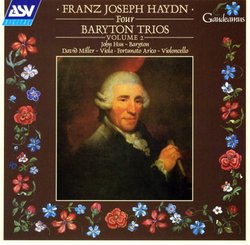| All Artists: Franz Joseph Haydn, John Hsu (Baryton), David Miller (Viola), Fortunato Arico (Cello) Title: Franz Joseph Haydn: Four Baryton Trios, Volume 2 Members Wishing: 0 Total Copies: 0 Label: Gaudeamus Release Date: 7/25/2000 Genre: Classical Styles: Chamber Music, Historical Periods, Classical (c.1770-1830), Instruments, Strings Number of Discs: 1 SwapaCD Credits: 1 UPC: 743625010923 |
Search - Franz Joseph Haydn, John Hsu (Baryton), David Miller (Viola) :: Franz Joseph Haydn: Four Baryton Trios, Volume 2
 | Franz Joseph Haydn, John Hsu (Baryton), David Miller (Viola) Franz Joseph Haydn: Four Baryton Trios, Volume 2 Genre: Classical
|
Larger Image |
CD Details |
CD ReviewsJohn Hsu as Baryton Pioneer Leslie Richford | Selsingen, Lower Saxony | 04/26/2008 (5 out of 5 stars) "Franz-Joseph Haydn (1732 - 1809): Four Baryton Trios Vol. 2 (Trio No. 71 in A major; No. 113 in D major; No. 96 in B minor; Nr. 126 in C major). Performed by: John Hsu, Baryton; David Miller, viola; Fortunato Arico, violoncello. A recording by the Musical Heritage Society (neither the place nor the date of the recording are given in the accompanying booklet). First published in 1988 as ASV Gaudeaumus GAU 109. Total playing time: 51'57".
This pioneering disc has to get five stars, if only because John Hsu is one of the few modern musicologists who has made an in-depth study of the baryton and can play it exceptionally well. On this recording, he plays a copy (by George Cassis of Baltimore) of an instrument with six bowed and nine plucked strings such as Haydn's employer, Prince Nicholas Esterházy, used to enjoy playing. The baryton was, even in those days, something of an exotic instrument, for which only comparatively little music was written. Anyone who wants to know what a baryton looks like should enter the word "baryton" in the search-box of a well-known internet encyclopedia where he will find not only a description but also a photograph. The instrument is something of a combination of viola da gamba and harp, the "harp" strings being on the back of the instrument so that they have to be plucked "blindly". These plucked strings sound somewhat similar to a harpsichord and could be made to play the basso continuo if the player was skilled enough. Prince Esterházy was an enthusiast, but his technique was, apparently, rather limited, and the 126 trios which Haydn wrote for this instrument in no wise make use of all the possibilities, as they were to be played by the composer's employer. For this reason, it is legitimate to feel that the music is fairly straightforward, which, of course, is not at all detrimental to its entertainment value. The analogue recording from the year 1987 (?) is very clear and well-done; the historical instruments of the accompaniment are played tastefully, if somewhat reticently." |

 Track Listings (12) - Disc #1
Track Listings (12) - Disc #1